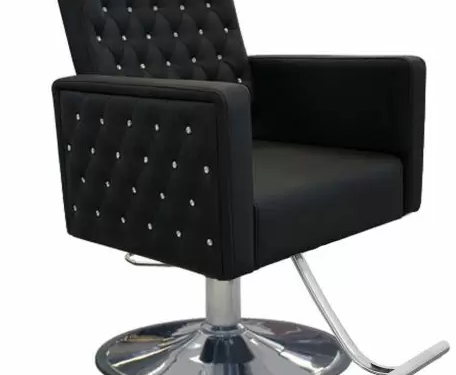The layout of your salon has a huge impact on both the atmosphere and the overall client experience. One key element of your salon’s design is the space between your stations. Getting this right not only affects how your salon looks but also how smoothly things run behind the scenes. Let’s talk about how to determine the perfect amount of space between your salon stations.
The Importance of Space Between Salon Stations
A lot more goes into the layout of a salon than just fitting furniture and equipment into a room. Space between salon stations plays a major role in making sure your clients feel comfortable and your stylists can do their best work.
Having the right amount of room helps create a relaxed atmosphere, so clients don’t feel cramped or overcrowded. It’s also important for the stylists, who need room to move around freely without feeling restricted by the furniture or the flow of the space.
Think about it this way: you want enough space for clients to sit comfortably and for your stylists to work without constantly bumping into each other. Too little space might create a feeling of tension or make your salon look cluttered. Too much space, on the other hand, can make your salon feel disconnected, like there’s too much room to fill. Finding the right balance is key.
Standard Space Guidelines for Salon Stations
So, how much space is enough? The general rule of thumb is that there should be about 4 to 6 feet between each salon station. This gives both the stylist and the client enough room to move comfortably. If your stations are designed with larger equipment, like hydraulic chairs or wide mirrors, you may need to adjust the distance slightly to accommodate these items.
In addition to the measurements for the chairs themselves, you need to think about the area around them. A stylist needs enough space to move around their client without bumping into other furniture or equipment.
You also want enough room to store styling tools, products, and towels—things that stylists frequently need to grab during a session. So while 4 to 6 feet is a good starting point, the exact measurement may vary depending on the size of your equipment and your salon layout.
Factors That Affect the Space Between Salon Stations
Now that you have a general idea of how much space is needed, let’s look at some factors that can influence the actual layout.
● Salon Layout and Floor Plan
How your salon is set up will directly affect how much space you have to work with. An open-concept layout may give you more flexibility in spacing, but it can also require more careful planning to avoid a disorganized feel. If you’re working with a smaller salon or have limited floor space, you may need to be more creative in how you arrange the stations.
● Type of Services Offered
The services you provide will impact the space you need. A haircutting station requires less room than a full-body massage or facial station. Nail stations, which often include additional equipment like UV lights, polishes, and manicure tools, also require more space. Think about how much room you need to comfortably perform each service while keeping everything within arm’s reach.
● Local Regulations
Depending on where your salon is located, you may be subject to local regulations that dictate how much space should be between your stations. These rules are often in place for safety reasons, such as fire codes or hygiene standards. Be sure to check with your local authorities to make sure your layout meets these guidelines.
● Traffic Flow
One thing you don’t want is for your salon to feel like a busy street corner. People moving around should be able to do so without bumping into each other or getting in the way. Keeping a good flow through the space means clients can move freely from one area to another, and your stylists won’t feel like they’re tripping over furniture. Make sure you have a clear path from one station to another and leave room for people to walk without causing a bottleneck.
● Equipment and Furniture Size
Your furniture and the size of your equipment play a role in determining how much space is needed. Bigger chairs and wide mirrors may require more room, so take measurements before you arrange everything. When you’re shopping for salon stations, consider compact models that fit in smaller spaces without sacrificing style or function.
Maximizing Space in Smaller Salons
Not all salons have the luxury of space to spread everything out. If you’re working with a smaller area, don’t worry—there are ways to make the most of what you’ve got.
Creative Design Tips
In a smaller salon, consider modular furniture that can be swiftly moved or adjusted. Stations with built-in storage can help reduce clutter and make the most of available space. Look for pieces that are compact but still functional, and keep the design clean and simple.
Use Vertical Space
Don’t forget about your walls! Vertical storage can help keep things organized and free up floor space for movement. Shelves, wall-mounted mirrors, and hanging storage can help you create more room without sacrificing your station’s functionality.
Mirrors and Lighting
Mirrors can make a small space feel bigger. By strategically placing mirrors around your salon, you can create the illusion of more space while maintaining a clean, open look. Proper lighting will also help the space feel airy and welcoming.
Conclusion
Determining the perfect amount of space between your salon stations isn’t just about fitting everything into a room—it’s about creating an environment where your clients feel relaxed, and your stylists can do their best work. Think about the layout, the type of services you offer, and the equipment you have when planning your salon design. In the end, the right space not only makes your salon more efficient but helps create an atmosphere that keeps clients coming back.
Remember, the space between your salon stations is more than just a design choice. It’s an investment in comfort, efficiency, and the overall experience you offer. So, take your time, measure carefully, and create a space where everyone feels at ease. After all, a little extra space can make all the difference in the world.






